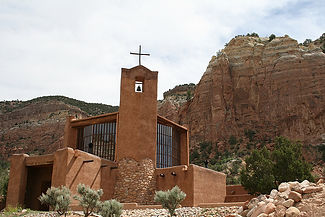Visit Places in Abiquiú
Interesting places within a 30-minute drive

Abiquiú Dam

Crossing the Rio Chama, the Abiquiú Dam opened in 1963, after seven years of construction. Built as a massive earth embankment, you can drive over the top and down the back side to see how it works. The Dam provides electricity for the area and forms Abiquiú Lake.
Abiquiú Lake

Abiquiú Lake is a 5,200-surface-acre reservoir that is surrounded by million-year-old red rocks and Cerro Pedernal. The lake –– peaceful, calm and beautiful –– offers some of the finest fishing in northern New Mexico. Reptile fossils 200 million years old have been found in the area.
Abiquiú Village

The village of Abiquiú has a downtown square with Georgia O'Keeffe's home, St. Thomas Church, old adobe ruins and a very cool artifact/furniture store called Bosshard Gallery. Shop at Bodes General Store, which first opened in 1890 as Grants Mercantile.
Cerro Pedernal

The famous flat-topped Cerro Pedernal, locally known as just Pedernal, can be spotted from miles away. The mountain lies in the Jemez Mountains and its highest point is 9,862 feet (3,006 meters). Pedernal ranks as the 255th highest mountain in New Mexico and the 4695th highest mountain in the United States. If you climb it, find the guest book at the top and be sure to sign it. Georgia O’Keeffe painted many artworks of Pedernal, and her ashes were scatter on its top after her death. She gave it the nickname, Old Flattop.
Monastery of Christ in the Desert

The peaceful and beautiful Monastery of Christ in the Desert is worth a visit on days of good weather. The Monastery is located on the shore of the Chama River, in the Chama Canyon Wilderness. We suggest visiting when you can observe Vespers.
The roads back to the Monastery are dirt, rocky and bumpy. It's not so easy to get to (and don't even try it when the roads are wet), but it is worth the trip!
Plaza Blanca

With its limestone cliffs, oddly shaped rocks, 60-foot high obelisks and spires, Plaza Blanca was immortalized by Georgia O'Keeffe in her 1940 painting, “The White Place.” The sites was also where much of Cowboys and Aliens was filmed and where the spaceship was located. Whether you hike the area or take the short walk in, it's a site worth seeing in person.
Poshuouinge Pueblo

Referred to as the Turquoise Ruin, the Poshuouinge Pueblo is a steep, scenic half-mile ruin trail. Two stunning vistas overlook the Rio Chama Valley, showcasing the large pueblo with over 700 ground-floor rooms around two large plazas and a kiva.
Purple Lavender Farm

A visit to the Purple Adobe Lavender Farm is about the experience –– a beautiful place near the Rio Chama. Walk the farm, visit, relax and enjoy a peaceful surrounding. Tea house and gift shop are also on site.
Puye Cliff Dwellings

Ruins of abandoned pueblos, the Puye Cliff Dwellings are located in Santa Clara Canyon on the Santa Clara Pueblo land near Abiquiu. Established in the late 1200s or early 1300s and abandoned by about 1600, this is among the largest of the prehistoric Indian settlements on the Pajarito Plateau, showing a variety of architectural forms and building techniques. The site was declared a National Historic Landmark in 1966.
Santa Rosa de Lima Ruins

Thought to have been built in the 1740s, the Santa Rosa de Lima ruins are a reminder of area history. Mounds adjacent to the church are where adobe houses once stood. Still thought to be a spiritual site, people leave flowers, luminaries, photos and prayer requests. It’s also a popular stop for photographers. The ruins are listed in the National Register of Historic Places.
St. Thomas the Apostle

The site of two previous Catholic churches, the current Santo Tomás el Apóstol de Abiquiú was designed by architect John Gaw Meem in 1935. The massive structure built of 48,000 adobes, the church is an example of classic colonial architecture. The parish celebrates religious and cultural traditions and advocates for charity and respect.

